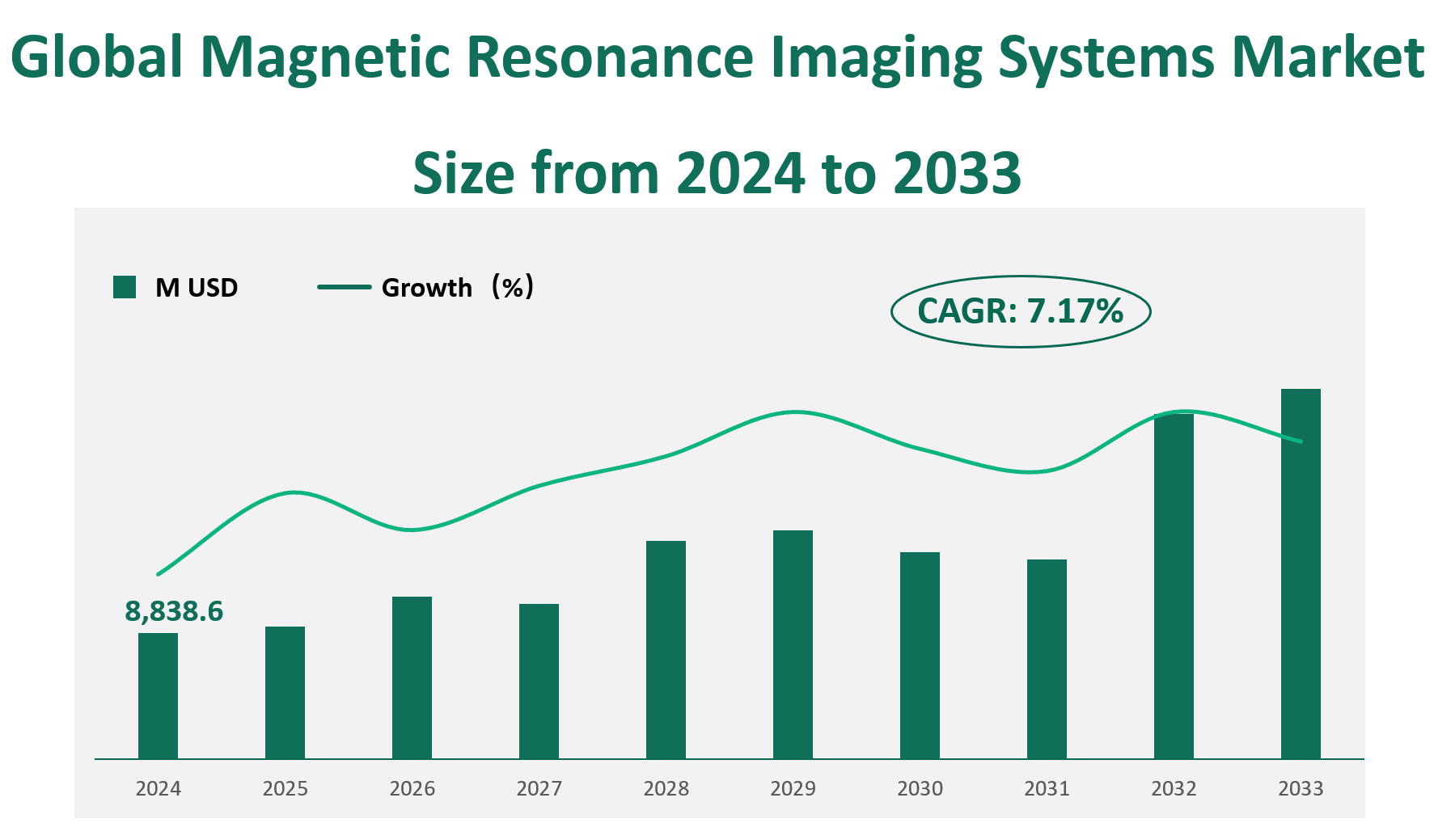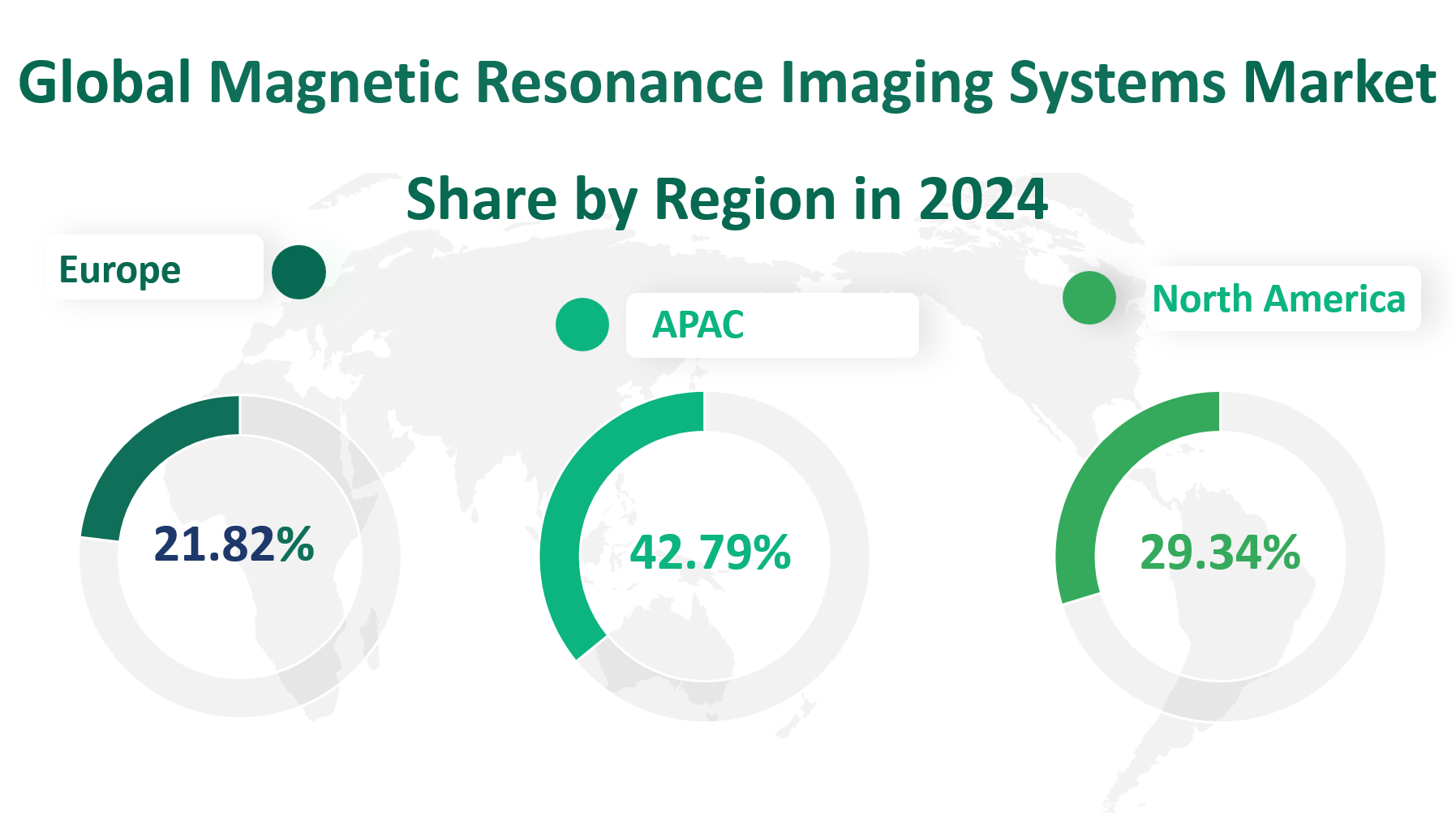1. Global Magnetic Resonance Imaging Systems Market Insight Analysis
The global Magnetic Resonance Imaging (MRI) Systems market is poised for significant growth in the coming years. In 2024, the global Magnetic Resonance Imaging (MRI) Systems market value is approximately $8,838.6 million, with a Compound Annual Growth Rate (CAGR) of 7.17% from 2024 to 2033.
Magnetic Resonance Imaging (MRI) Systems are sophisticated medical imaging devices that utilize powerful magnetic fields, radio waves, and computer technology to generate detailed images of the internal structures of the human body. Unlike traditional X-ray and CT scans, MRI does not use ionizing radiation, making it a safer option for patients. Instead, it relies on the magnetic properties of hydrogen atoms within the body to produce high-resolution images of organs, tissues, and bones.
MRI systems are categorized into two main types: Closed MRI Systems and Open MRI Systems. Closed MRI Systems are designed with a cylindrical tube-like structure that surrounds the patient, providing high-resolution images but may cause discomfort for claustrophobic patients. Open MRI Systems, on the other hand, have a more open design, allowing for greater patient comfort while still delivering high-quality images. These systems are particularly beneficial for patients who are obese, elderly, or have difficulty lying still for extended periods.
Figure Global Magnetic Resonance Imaging Systems Market Size (M USD) and CAGR (2024-2033)

2. Driving and Limiting Factors of Magnetic Resonance Imaging Systems Market Growth
The growth of the MRI Systems market is driven by several key factors. Firstly, the increasing prevalence of chronic diseases such as cancer, cardiovascular diseases, and neurological disorders has led to a higher demand for advanced diagnostic imaging technologies. MRI systems offer unparalleled detail and accuracy in detecting these conditions, making them an essential tool in modern healthcare.
Secondly, technological advancements in MRI technology have significantly improved the capabilities and efficiency of these systems. Innovations such as ultra-high field MRI systems (7T and above) provide even higher resolution images, enabling more precise diagnoses and better treatment outcomes. Additionally, advancements in artificial intelligence and machine learning are being integrated into MRI systems to enhance image analysis and reduce diagnostic time.
Thirdly, the growing awareness of the importance of early disease detection and the increasing availability of healthcare services in developing countries are driving the demand for MRI systems. As more people gain access to advanced medical care, the need for reliable and accurate diagnostic tools like MRI systems is expected to rise.
Despite the significant growth potential, the MRI Systems market faces several challenges. One of the primary limiting factors is the high cost of MRI systems, which can be prohibitive for smaller healthcare facilities and clinics. The cost of acquiring, maintaining, and operating these systems requires substantial financial investment, limiting their accessibility in some regions.
Another challenge is the technical complexity of MRI systems. The operation and maintenance of these devices require specialized training and expertise, which may not be readily available in all healthcare settings. Additionally, the industry is highly regulated, with stringent quality and safety standards that manufacturers must adhere to, adding to the complexity and cost of bringing new products to market.
Furthermore, the market is dominated by a few major players, such as Siemens Healthineers, General Electric, and Philips, which can limit competition and innovation. These companies hold a significant share of the market, making it difficult for new entrants to gain a foothold.
3. Technology Innovation and Corporate Mergers and Acquisitions in Magnetic Resonance Imaging Systems Market
The MRI Systems market is characterized by continuous technological innovation and strategic corporate activities. Companies are constantly investing in research and development to enhance the capabilities of MRI systems. For example, Siemens Healthineers has launched the MAGNETOM Terra, a 7T MRI scanner designed for unprecedented breakthroughs in clinical care. This system offers submillimeter resolution and advanced imaging capabilities, setting a new standard in the industry.
In addition to technological advancements, the market has also seen significant corporate mergers and acquisitions. These strategic moves are aimed at expanding market share, enhancing product portfolios, and leveraging synergies between companies. For instance, the acquisition of Toshiba Medical Corporation by Canon has allowed Canon to integrate its optical and imaging technologies with Toshiba’s medical imaging diagnostic capabilities, resulting in innovative MRI solutions.
4. Global Magnetic Resonance Imaging Systems Market Size by Type
Magnetic Resonance Imaging Systems are medical devices that use strong magnetic fields and radio waves to generate detailed images of the internal structures of the body. These systems are categorized into two main types: Closed MRI Systems and Open MRI Systems.
Closed MRI Systems are the traditional and most common type of MRI machines. They feature a cylindrical tube-like structure where the patient is placed inside. These systems offer high-resolution imaging due to their strong magnetic fields and advanced technology. Closed MRI Systems are particularly effective for detailed scans of the brain, spine, and other internal organs. Their design allows for a more uniform magnetic field, resulting in higher image quality and faster scanning times.
Closed MRI Systems dominate the market with a significant share. In 2024, the market value of Closed MRI Systems is approximately USD 7,320.7 million. This type of MRI system holds the largest market share, accounting for about 82.83% of the total MRI systems market. The dominance of Closed MRI Systems can be attributed to their superior imaging capabilities, which are essential for precise medical diagnostics.
Open MRI Systems, on the other hand, are designed with a more open structure, allowing for greater patient comfort and accessibility. These systems are particularly beneficial for patients who experience claustrophobia or require scans in a more open environment. Open MRI Systems are commonly used for extremity imaging and other applications where patient positioning is critical.
The market value of Open MRI Systems in 2024 is around USD 1,517.9 million. Although they offer unique advantages, Open MRI Systems hold a smaller market share compared to Closed MRI Systems, accounting for approximately 17.17% of the total market.
Table Global Magnetic Resonance Imaging Systems Market Size by Type in 2024
Market Size (M USD) 2024 | Market Share | |
Closed MRI Systems | 7320.7 | 82.83% |
Open MRI Systems | 1517.9 | 17.17% |
5. Global Magnetic Resonance Imaging Systems Market Size by Application
Magnetic Resonance Imaging Systems are utilized across various medical applications, each with specific requirements and market dynamics. The primary applications include Hospitals, Clinics, Diagnostic Centers, Research Laboratories, and Ambulatory Care Centers.
Hospitals are the largest consumers of MRI systems, utilizing them for a wide range of diagnostic procedures. MRI scans are essential for detecting and diagnosing various medical conditions, including brain disorders, spinal injuries, and soft tissue abnormalities. Hospitals require high-performance MRI systems to handle a large volume of patients and complex medical cases.
In 2024, the market value of MRI systems used in hospitals is around USD 4204.8 million. Hospitals account for the largest market share, holding approximately 47.57% of the total MRI systems market.
Clinics also utilize MRI systems, albeit on a smaller scale compared to hospitals. They primarily focus on routine diagnostic procedures and follow-up scans. MRI systems in clinics are often used for less complex cases, providing essential diagnostic support.
The market value of MRI systems in clinics in 2024 is around USD 2189.6 million. Clinics hold a market share of approximately 24.77%, reflecting their significant but secondary role in the overall MRI systems market.
Diagnostic centers specialize in providing imaging services, including MRI scans, to patients referred by physicians. These centers focus on delivering high-quality diagnostic results and often collaborate with hospitals and clinics.
The market value of MRI systems in diagnostic centers in 2024 is around USD 1433.6 million. Diagnostic centers hold a market share of approximately 16.22%.
Research laboratories use MRI systems for advanced research and development purposes. These systems are crucial for studying brain function, drug development, and other scientific applications.
The market value of MRI systems in research laboratories in 2024 is projected to be around USD 277.2 million. Research laboratories hold a smaller market share of approximately 3.14%.
Ambulatory care centers provide outpatient services, including MRI scans, for patients who do not require hospitalization. These centers focus on efficient and accessible diagnostic services.
The market value of MRI systems in ambulatory care centers in 2024 is estimated to be around USD 733.5 million. Ambulatory care centers hold a market share of approximately 8.3%.
Table Global Magnetic Resonance Imaging Systems Market Size by Application in 2024
Application | Market Size (M USD) 2024 |
Hospitals | 4204.8 |
Clinics | 2189.6 |
Diagnostic Centers | 1433.6 |
Research Laboratories | 277.2 |
Ambulatory Care Centers | 733.5 |
6. Global Magnetic Resonance Imaging Systems Market by Top Regions
North America is projected to hold a substantial share of the global MRI Systems market in 2024. The region’s market value is expected to reach around $2,593.2 million, driven by the United States’ dominant position in medical technology and healthcare spending.
Europe is another significant player in the global MRI Systems market, with an estimated market value of $1,928.4 million in 2024. The region is characterized by advanced healthcare systems and a high demand for high-quality diagnostic tools.
Asia Pacific is the fastest-growing region in the MRI Systems market, with an estimated market value of $3,782.0 million in 2024. The region’s growth is driven by rapid economic development, increasing healthcare spending, and a growing awareness of the importance of advanced diagnostic tools.
South America is projected to have a market value of $321.9 million in 2024. The region’s market is driven by Brazil, Argentina, and Chile, which are the largest economies in South America.
Middle East and Africa is expected to have a market value of $213.1 million in 2024. The region’s market is driven by countries such as the United Arab Emirates, Saudi Arabia, and Egypt.
Figure Global Magnetic Resonance Imaging Systems Market Size by Region in 2024

7. Global Magnetic Resonance Imaging Systems Market Analysis by Major Players
7.1 Siemens Healthineers AG
Company Introduction and Business Overview: Siemens Healthineers is a leading global provider of medical imaging and diagnostic solutions. Established in 1847 and headquartered in Germany, the company is known for its innovative and high-quality medical technologies. Siemens Healthineers operates worldwide and focuses on improving patient outcomes through advanced imaging solutions.
Products Offered: Siemens Healthineers offers a comprehensive range of MRI systems, including the MAGNETOM Terra, a 7T MRI scanner designed for clinical and research applications. The company’s MRI systems are known for their high-resolution imaging capabilities, advanced clinical applications, and user-friendly interfaces.
7.2 General Electric Company
Company Introduction and Business Overview: General Electric (GE) is a multinational conglomerate with a significant presence in the medical imaging sector. Established in 1892 and headquartered in the United States, GE offers a wide range of medical technologies and solutions. The company’s healthcare division focuses on providing advanced imaging systems to improve diagnostic accuracy and patient care.
Products Offered: GE’s MRI systems include the SIGNA™ Premier AIR™ Edition 3.0T MRI scanner, which offers advanced imaging capabilities, improved workflow efficiency, and enhanced patient comfort. The company’s MRI systems are designed to meet the needs of various healthcare settings, from hospitals to diagnostic centers.
7.3 Koninklijke Philips N.V.
Company Introduction and Business Overview: Philips is a health technology company focused on improving people’s health across the health continuum. Established in 1891 and headquartered in the Netherlands, Philips offers a wide range of medical imaging solutions, including MRI systems. The company is known for its commitment to innovation and improving patient outcomes through advanced technologies.
Products Offered: Philips’ MRI systems include the Ingenia Elition 3.0T, which offers advanced imaging capabilities, improved workflow efficiency, and enhanced patient comfort. The company’s MRI systems are designed to meet the needs of various healthcare settings, from hospitals to diagnostic centers.

